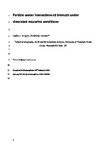Particle-water interactions of bismuth under simulated estuarine conditions
| dc.contributor.author | Knight, LJ | |
| dc.contributor.author | Turner, Andrew | |
| dc.date.accessioned | 2020-04-13T14:24:38Z | |
| dc.date.issued | 2020-07 | |
| dc.identifier.issn | 0045-6535 | |
| dc.identifier.issn | 1879-1298 | |
| dc.identifier.other | 126400 | |
| dc.identifier.uri | http://hdl.handle.net/10026.1/15559 | |
| dc.description.abstract |
Although the production and usage of bismuth (Bi) have been increasing, very little is known about the environmental behaviour of this heavy metal. In the present study, the particle-water interactions of Bi are examined under controlled conditions in which the metal is added as a tracer to estuarine sediment suspended in different, environmentally-relevant aqueous solutions. Adsorption isotherms were always linear over the Bi concentration range employed (up to 2000 μg L-1) and sediment-water distribution coefficients derived from isotherm gradients, KD (L kg-1), displayed an inverse dependence on pH in river water (and ranging from KD = 106,000 L kg-1 at pH 5.0 to KD = 17,700 L kg-1 at pH 9.0) that were consistent with the adsorption of hydroxo-complexes to the sediment surface. Higher adsorption in ultra-pure water of the same pH as river water and an order of magnitude increase in adsorption in seawater at pH 8.0 (KD = 1,530,000 L kg-1) and 0.7 M NaNO3 at pH 6.5 (KD = 4,290,000 L kg-1), however, required the presence of additional species or processes that are likely related to organic complexation of the metal. Thus, experiments conducted in mixtures of river water and seawater in the absence of sediment suggested that Bi may also be bound to colloidal organic molecules that undergo flocculation and salting out on estuarine mixing. Compared with other metals studied under similar conditions, Bi displays a high reactivity towards sediment particles and is, therefore, predicted to be retained in estuaries to a significant extent from catchment sources. | |
| dc.format.extent | 126400-126400 | |
| dc.format.medium | Print-Electronic | |
| dc.language | en | |
| dc.language.iso | en | |
| dc.publisher | Elsevier BV | |
| dc.subject | Bismuth | |
| dc.subject | Adsorption | |
| dc.subject | Rivers | |
| dc.subject | Estuaries | |
| dc.subject | Sediment | |
| dc.subject | Flocculation | |
| dc.title | Particle-water interactions of bismuth under simulated estuarine conditions | |
| dc.type | journal-article | |
| dc.type | Journal Article | |
| plymouth.author-url | https://www.webofscience.com/api/gateway?GWVersion=2&SrcApp=PARTNER_APP&SrcAuth=LinksAMR&KeyUT=WOS:000533642900091&DestLinkType=FullRecord&DestApp=ALL_WOS&UsrCustomerID=11bb513d99f797142bcfeffcc58ea008 | |
| plymouth.volume | 251 | |
| plymouth.publication-status | Published | |
| plymouth.journal | Chemosphere | |
| dc.identifier.doi | 10.1016/j.chemosphere.2020.126400 | |
| plymouth.organisational-group | /Plymouth | |
| plymouth.organisational-group | /Plymouth/Faculty of Science and Engineering | |
| plymouth.organisational-group | /Plymouth/Faculty of Science and Engineering/School of Geography, Earth and Environmental Sciences | |
| plymouth.organisational-group | /Plymouth/REF 2021 Researchers by UoA | |
| plymouth.organisational-group | /Plymouth/REF 2021 Researchers by UoA/UoA07 Earth Systems and Environmental Sciences | |
| plymouth.organisational-group | /Plymouth/Research Groups | |
| plymouth.organisational-group | /Plymouth/Research Groups/BEACh | |
| plymouth.organisational-group | /Plymouth/Research Groups/Marine Institute | |
| plymouth.organisational-group | /Plymouth/Users by role | |
| plymouth.organisational-group | /Plymouth/Users by role/Academics | |
| dc.publisher.place | England | |
| dcterms.dateAccepted | 2020-02-29 | |
| dc.rights.embargodate | 2021-3-4 | |
| dc.identifier.eissn | 1879-1298 | |
| dc.rights.embargoperiod | Not known | |
| rioxxterms.versionofrecord | 10.1016/j.chemosphere.2020.126400 | |
| rioxxterms.licenseref.uri | http://www.rioxx.net/licenses/all-rights-reserved | |
| rioxxterms.licenseref.startdate | 2020-07 | |
| rioxxterms.type | Journal Article/Review |


